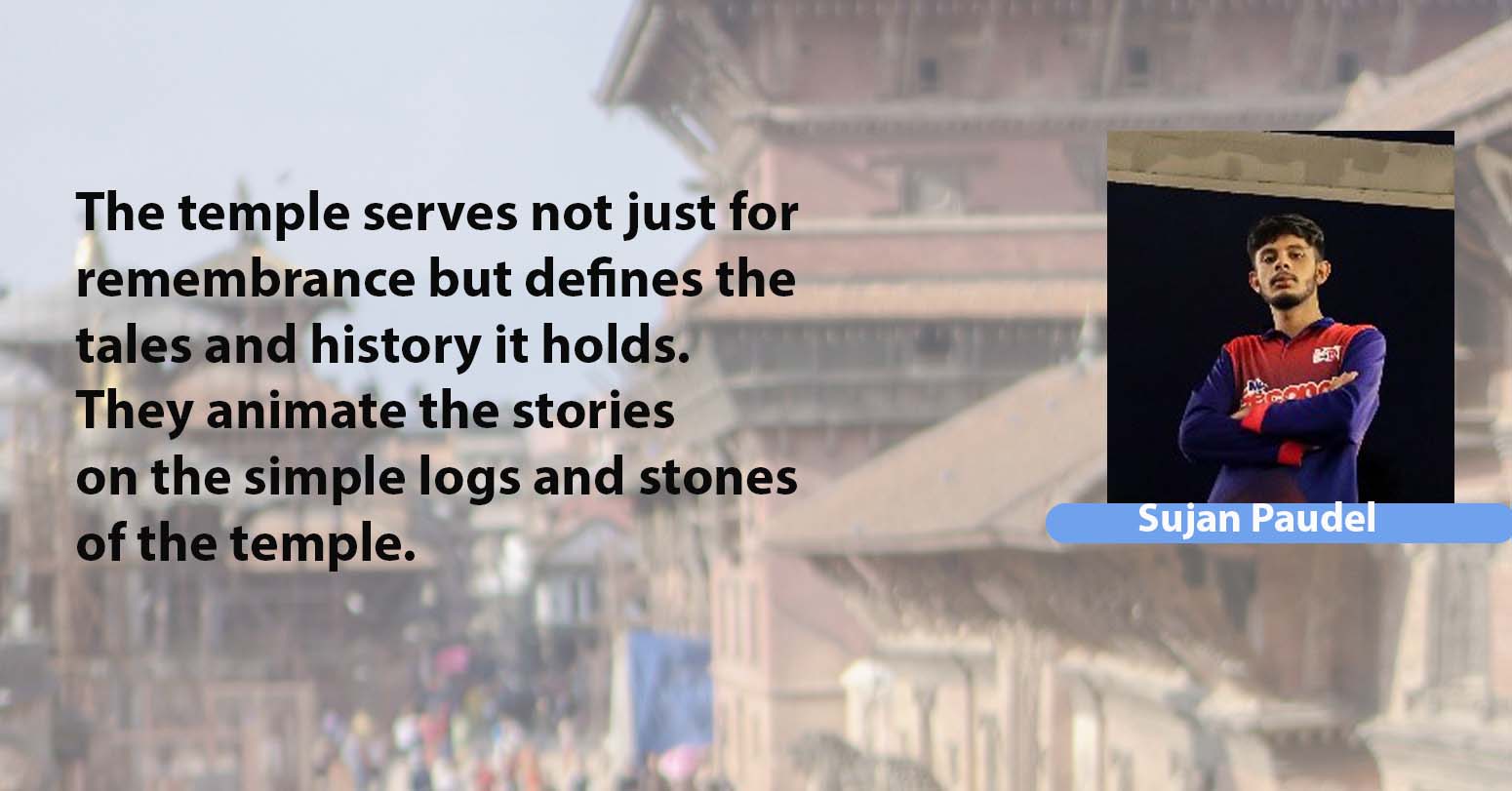
- Sujan Paudel
What is the function of a door?
Your answer would probably be "the hinged barrier that allows entry and exit from the building."
Now, for the window, the same question: if I were you, I would say it is to view the world behind the building's wall, to let the sun in and give its service through the small portals, to provide a breeze to your room, and to stole privacy. The wind can later whisper the things you are doing in your room. She is cheeky as always, isn't she?
Then, what do your lintel and sill do in your building? They share the same intense burden you want to share with others but never got the chance to. She always did, to the brick beneath her, and always took the burden from above her. Wow, she is just like karma.
Have you ever been to Kathmandu? There, you can find different heritage sites. The Kathmandu Valley, in particular, has numerous temples of different styles/types—shikhara, dome, and tiered temples. The tiered temples also vary from single-tiered to five-tiered temples with their distinctive features. Nepal has a variety of distinctive architectural features which are represented in residential, religious, and public buildings. Much of Nepal’s architectural history is aligned with the dynasties that ruled at a particular time. Global industrialization, which occurred between the 18th and 19th centuries, transformed most of the world’s construction.
They were constructed by the Licchavi dynasty (Vaishnav temple, Buddhist stupa of Swayambhu), the Shah dynasty (Kasthamandap, various temples, fountains, and other important buildings), and the Rana dynasty (luxurious palaces which have been turned into government buildings).
When I go to these heritage sites, I can stare at their doors and windows forever. Once I visited the Taleju Temple and spent an hour animating the curves of the door in my mind. What I saw was that Karl Bhairav and Bhadrakali had defeated the demon from Kathmandu city. Their stances all over the door, the multiple hands with different items, the weapons they held, the intensity of their rage, and the aura that gave humanity a new ray of hope were mesmerizing.
I have visited different heritage sites in Kathmandu. Just like in the Taleju Temple, I have gone to Pashupatinath, where I can see the carvings in different places of the temple. I can visualize the innocence of Shiva, his different avatars, his kindness towards his devotees, and his rage towards the demons. His tandav dance can also be visualized by seeing the carvings.
What I admire the most is the artists. Their effort towards this craft is incredible. By seeing this, I want to learn their passion and patience. They spent a part of their lives learning how to carve. I also want to learn the calmness they must have when their art gets messed up. I imagine they must have more rage than Kali when their art gets ruined.
They tell tales through these doors and windows. They animate the stories on the simple logs and stones of the temple. The temple serves not just for remembrance but defines the tales and history it holds.
I often wander in these places. I see people only talking in front of them and ignoring the symbolism in these logs and stones. They take photos to remember the moments they had in that temple, but they forget the temple has its own tale to tell.
Do these doors and windows start to ignore the people to tell the tale? Or have they become exhausted by speaking the tale? Or is their storytelling job only for the older generation? Are these things getting old, and the tale itself getting old?
I don't think this is the case. The new generation just ignores these things. They have more important things to do than stare at some old logs. They have social media accounts to handle. They want a nice photo to click in these places so they can impress others or keep a remembrance of the place.
There is a famous saying, "A generation which ignores history has no past and no future," and these monuments are the history of Nepal. At the universities of Nepal, there are not many students interested in the past. Does this mean this generation is meant to be doomed?
Due to unemployment and a decrease in demand, carpenters are going abroad for a better lifestyle. Newcomers seem to be discouraged by these situations. There was satisfactory employment in the past because houses in Kathmandu used those types of frames. Also, due to migration, non-native people discard the adoption of Newari craftsmanship culture.
I want to request this generation to at least respect history and take a look at the magnificent craftsmanship around Kathmandu or Nepal. By doing so, you will appreciate those craftsmen who worked hard to tell you the story.


















Middle-aged man spends millions to
Breathing The Unbreathable Air
Comprehensive Data Protection Law Critically
Gender Differences In Mental Healthcare
Dr. Dharam Raj Upadhyay: Man
Erosion of Democracy